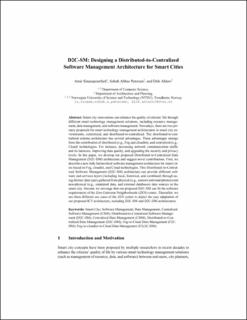| dc.description.abstract | Smart city innovations can enhance the quality of citizens’ life through different smart technology management solutions, including resource management, data management, and software management. Nowadays, there are two primary proposals for smart technology management architectures in smart city environments, centralized, and distributed-to-centralized. The distributed-to-centralized schema architecture has several advantages. These advantages emerge from the contribution of distributed (e.g., Fog and cloudlet), and centralized (e.g., Cloud) technologies. For instance, decreasing network communication traffic and its latencies, improving data quality, and upgrading the security and privacy levels. In this paper, we develop our proposed Distributed-to-Centralized Data Management (D2C-DM) architecture and suggest novel contributions. First, we describe a new fully hierarchical software management architecture for smart cities based on Fog, cloudlet, and Cloud technologies. This Distributed-to-Centralized Software Management (D2C-SM) architecture can provide different software and services layers (including local, historical, and combined) through using distinct data types gathered from physical (e.g., sensors and smartphones) and non-physical (e.g., simulated data, and external databases) data sources in the smart city. Second, we envisage that our proposed D2C-SM can fit the software requirements of the Zero Emission Neighborhoods (ZEN) center. Thereafter, we use three different use cases of the ZEN center to depict the easy adaptation of our proposed ICT architecture, including D2C-SM and D2C-DM architectures. | en_US |
